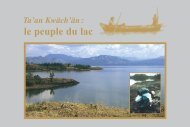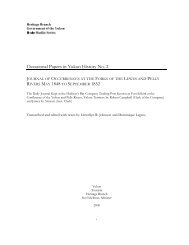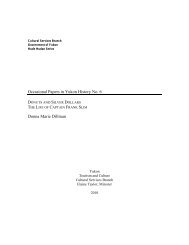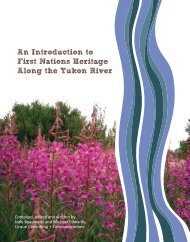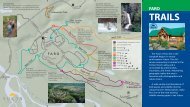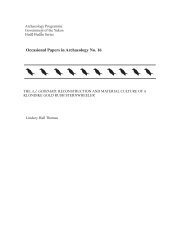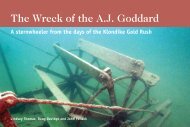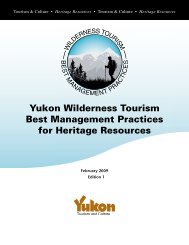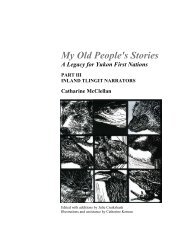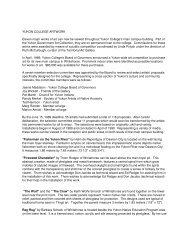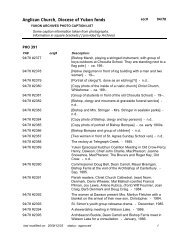Sustainable Tourism: The Tour Operators' Contribution
Sustainable Tourism: The Tour Operators' Contribution
Sustainable Tourism: The Tour Operators' Contribution
Create successful ePaper yourself
Turn your PDF publications into a flip-book with our unique Google optimized e-Paper software.
environmental programme in detail and describing the checklist. An ECO symbol highlights the hotels<br />
that have adopted ecological initiatives. <strong>The</strong> 33 questions in the checklist are numbered, and the number<br />
appears next to the ECO symbol to indicate which actions have been implemented by each of the hotels<br />
that completed the questionnaire, allowing clients to make comparisons and informed decisions when<br />
selecting their accommodation.<br />
Monitoring and evaluation of the effective implementation of the 33 criteria is conducted through<br />
customer feedback forms and routine visits by Orizzonti staff to the contractors. A customer feedback<br />
form (pre-addressed) is included in the brochure distributed with travel documents. <strong>The</strong> forms are<br />
collected and evaluated by the Environmental Monitoring Office. When customers file negative<br />
comments, Orizzonti requests explanations directly from the hotel manager. Technical support is<br />
offered, by both Check Soluzioni per il Turismo and Orizzonti staff, for suppliers expressing an interest<br />
in improving their environmental performance.<br />
Benefits<br />
<strong>The</strong> checklist has had a number of benefits, including greater awareness among stakeholders and an<br />
increasing number of requests for accommodation that complies with ecological criteria. Orizzonti has<br />
also received major press coverage for its action.<br />
Comments<br />
<strong>The</strong> main limitation to using a checklist is that it cannot include many criteria. <strong>The</strong> principal challenge for<br />
Orizzonti is to deliver the correct message to clients, hence the use of the numbers in the brochures rather<br />
than just the general ECO logo, to allow customers to know what each establishment does. Building<br />
awareness is a long-term challenge for Orizzonti, because it takes time to engage both the supply side (in<br />
this case the hoteliers) and the customers. Planned next steps for the environmental programme include<br />
revising the 33 criteria to take into account developments in national legislation and removing those that<br />
will already be required by law. Orizzonti will also build a database with which to assess annual progress<br />
made by each establishment.<br />
Box 1: <strong>The</strong> Orizzonti Environmental Checklist for Suppliers<br />
Water and Energy Saving<br />
<strong>The</strong> facility:<br />
1. uses low-energy light bulbs.<br />
2. uses a separate electrical circuit on each floor.<br />
3. switches off the electrical system at night.<br />
4. uses solar energy for the production of hot water.<br />
5. can modify light intensity.<br />
6. has a central vacuum system for cleaning the<br />
environment.<br />
7. has an air conditioning system with variable<br />
capacity.<br />
8. regularly maintains and cleans air conditioning<br />
filters.<br />
9. has air changing systems.<br />
10. allows clients to change the room or apartment<br />
temperature.<br />
11. uses aerators in sink and/or shower taps.<br />
12. has toilets with a flushing capacity of less than<br />
12 litres.<br />
13. collects and re-uses rain water.<br />
14. waters green areas during the night.<br />
15. waters green areas with grey water.<br />
16. checks light and water consumption periodically.<br />
Pollution<br />
<strong>The</strong> facility:<br />
1. has used non-toxic paints in internal decoration.<br />
2. has sound-proof rooms.<br />
3. is sound proof throughout.<br />
4. has given preference to wooden furniture.<br />
5. changes sheets and towels on request.<br />
6. uses low environmental impact products.<br />
7. analyses wastewater quality.<br />
8. has a separate green area for the clients.<br />
9. has analysed internal air quality.<br />
10. collects solid waste separately.<br />
11. collects glass separately.<br />
12. collects plastic separately.<br />
13. collects aluminium separately.<br />
14. collects paper and cardboard separately.<br />
15. has built the facility using mostly local inputs.<br />
16. raises client awareness by written notes.<br />
17. has separate smoking areas.<br />
<strong>Sustainable</strong> <strong><strong>Tour</strong>ism</strong>: <strong>The</strong> <strong>Tour</strong> Operators’ <strong>Contribution</strong> 3<br />
2. Supply Chain Management




